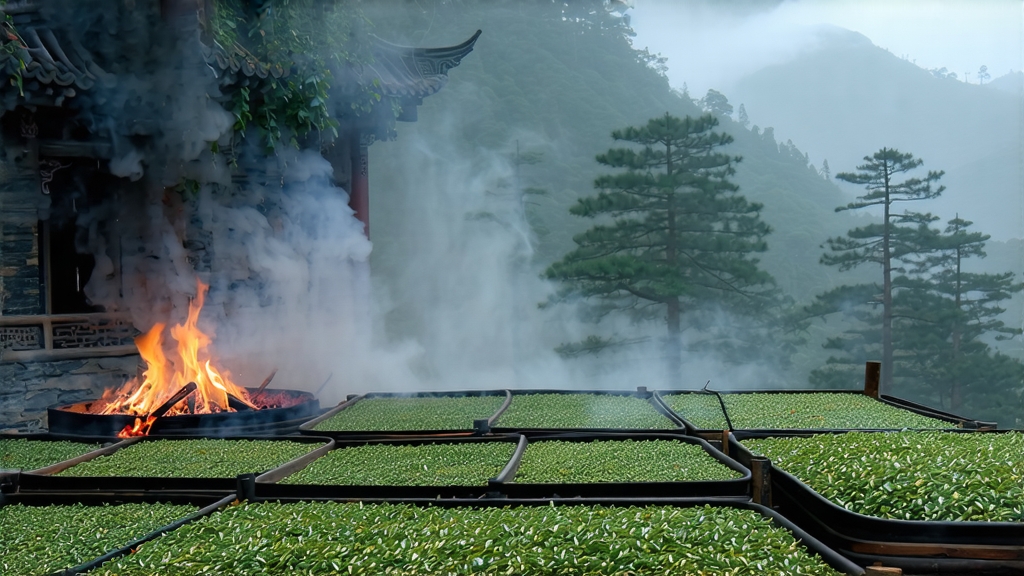
Long before Assam, Ceylon, or Earl Grey entered the global lexicon, the first fully oxidised leaf ever to leave China bore the name Lapsang Souchong. Western merchants phonetically rendered “Zheng Shan Xiao Zhong” into the brisk syllables we know today, but the original Chinese reveals more: “zheng shan” means “original mountain,” a strict demarcation of the micro-valley deep inside Fujian’s Wuyi massif where the style was born; “xiao zhong” refers to the small, slender cultivar leaves plucked in late spring. In the pantheon of Chinese hong cha (red tea), Lapsang Souchong is therefore both progenitor and outlier—an elegant, subtly smoky ambassador that taught seventeenth-century Europe what black tea could taste like.
History: From Ming-Era Accident to Global Sensation
Local legend places the birth of Lapsang Souchong during the late Ming dynasty, around 1604. Raiders supposedly delayed the annual harvest, forcing tea farmers to rush the drying process over open pine fires so the leaf would survive the long trek to market. The accidental smoke infusion proved wildly popular with Dutch and British traders docking at Xiamen’s port, who then ferried the tea to Amsterdam and London. By the early 1700s, bohea (a corruption of “Wuyi”) had become the costliest item on the East India Company ledgers, outpricing even green teas. The craving for “Souchong” leaves ignited botanical espionage—Robert Fortune’s 1848 mission to steal tea plants and Wuyi craftsmen for Himalayan plantations—thereby seeding the Indian tea industry. In other words, every modern breakfast blend can trace a genetic and technological lineage back to this rocky Fujian canyon.
Terroir: Why Only the Original Mountain Will Do
The Wuyi Mountains rise like graphite pillars from a subtropical river gorge, their granite cliffs trapping morning fog that diffuses sunlight into a soft, shifting lantern. Day-night temperature swings of 15 °C slow leaf growth, concentrating amino acids and volatile aromatics. The sandy, mineral-rich soil drains quickly, forcing tea roots to dive deep for nutrients and absorb the signature “yan yun” (rock rhyme) that local connoisseurs prize. Attempts to replicate Lapsang Souchong in flatland gardens—even within Fujian—yield a dull leaf that lacks the osmanthus-like sweetness and the capacity to absorb pine smoke without tasting acrid. Hence, the State Council of China has granted the core 600-hectare enclave around Tongmu Village a protected origin status akin to Champagne.
Cultivars: A Tale of Two Leaves
Traditional Lapsang Souchong relies on the Wuyi Cai Cha population, a mixed community of seed-propagated bushes that includes Xiao Ye Zhong (small leaf), Da Ye Zhong (large leaf), and the purple-veined Jiangbei variant. Each bush is allowed to reach shrub height, encouraging a taproot that channels minerals. In the 1960s, researchers released the clonal cultivar Zhenghe Da Bai for higher yield; while its downy buds create a prettier dry leaf, purists insist it smokes less elegantly. Consequently, premium producers now label “Old Bush Zheng Shan” to signal heirloom material whose average age exceeds eighty years.
Craft: The Eight Stages of Pine-Fire Alchemy
- Plucking: Only the standard “two leaves and a bud” shoot is taken when the lower leaf turns olive-green but still snaps crisply—usually the first week of May.
- Solar Withering: Baskets of leaf are spread on bamboo mats in direct morning sun for 20 minutes, initiating enzymatic activity and reducing grassy notes.
- Indoor Withering: The leaf is then moved onto slatted wooden racks inside a Qing dynasty-era loft for 4–6 hours, where mountain breezes continue dehydration until 60 % moisture remains.
- Rolling: A 55-cm diameter bamboo kneading tray is used to bruise cell walls without breaking the leaf; the goal is to express sap while preserving strip integrity for later smoke penetration.
- Oxidation: The rolled leaf is piled in copper-lined wooden boxes and covered with wet calico. For the next 5–7 hours, oxidases convert catechins into theaflavins, turning